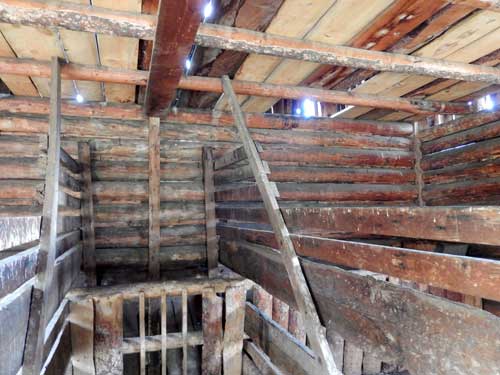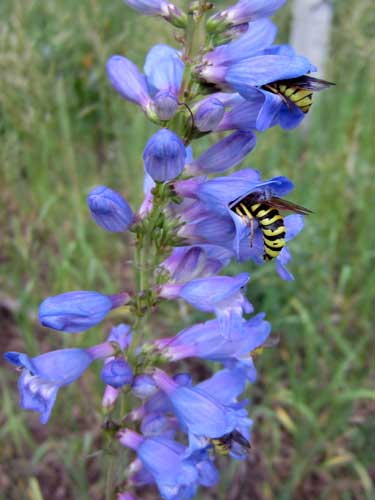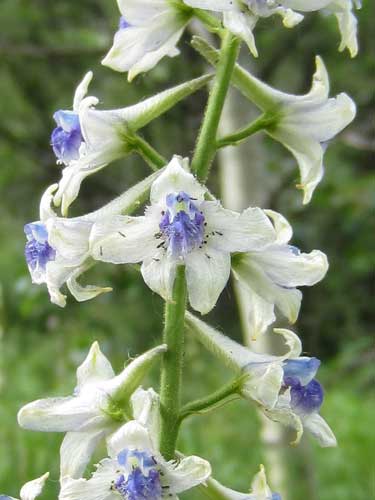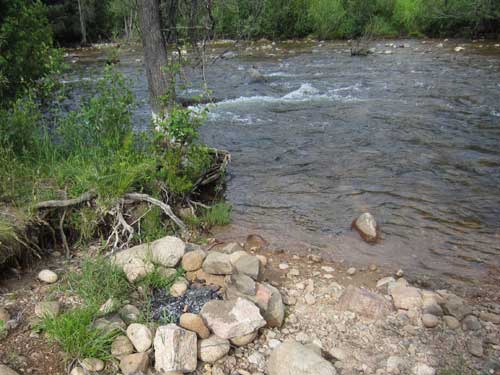The Mad Creek Barn was about 2 miles in. The trail we had been walking on was actually the old "Canyon Road," built around 1920 with a lot of dynamite!
The barn was built around 1906 (and restored in 2001). It represents the transition from the open range of the early West to the new era of Forest Service administration over federal lands. When Teddy Roosevelt created vast areas of national forest, this property became surrounded by public land. The barn was built by a local rancher, James Ratliff, who later became the first Forest Supervisor of the Routt National Forest (which were were currently in - it was still another few miles before we reached wilderness).


James "Harry" Ratliff




Yup, there were a lot of 'em out here.
After our brief visit (we didn't want to dillydally too long because of the potential storm), we continued on... although we weren't exactly sure which trail to take. There were lots of small ones leading away but nothing was marked. We ended up on a trail that led us down to the river and a bridge leading to another large trail. There were numerous small shacks in extreme states of disrepair.


What the?! Freeloader!

Just checkin' underneath for trolls. You never know.

Mad Creek



An old stove!

Not much left of this one!
We figured out where we were on the map, kept to our side of the river and were consoled that we would eventually meet up with our 'real' trail again.

We were on the small dotted line between the bridge and the Swamp Park Trail.

A quick look back

Pushing on through the very tall grass

An old fence marked what used to be the ranch's boundary.

Some old nails were.... wait... is that a grasshopper photobombing the shot?!
We continued on, with the scenery changing between small stands of trees and open meadow. The storm was moving in quickly and the wind had started to gust a bit. We saw a lovely stand of penstemons and were going to just walk quickly past but we noticed something odd... it seemed to be stuffed full with honeybees, but they weren't moving! Upon closer inspection, they appeared to be dead wasps. Jo reached out and touched one. It suddenly became animated, backing out and looking around to see what was going on. It eventually crawled back into the flower. What were they doing? Were they taking refuge from the approaching storm??



A disgruntled wasp emerges briefly.
I took a few photos then took a few steps down the trail out of the way so Jo could get his. It was hard because the wind was blowing the tall flower stalks all over the place. I watched as he took one small step off the trail to get a better angle. Suddenly there was a blood-curdling rattling sound! I saw Jo leap back at the same time as I saw the large rattlesnake also leap up from the grass. At first I thought it was lunging at him but fortunately it was just jumping to get away. It then regrouped itself into a mass of slithering coils, obviously very unhappy and still rattling loudly. It was very very thick but probably only about 4 feet long. We observed it for a short moment then felt it best to move along quickly.

The rattlesnake must have originally been at the base of the flowers right near the trail.

A slithery, angry heap o' poison
Once our hearts started beating normally again, we resumed our journey. From then on, however, we kept a closer eye on the trail and searched the ground thoroughly before stepping off into the tall grass! Jo offered to go first since he had bigger boots... just in case.

From super dense, lush ferns...

... to grassy meadows with flowers taller than us!

There are over two dozen bumblebee species in Colorado. Four of these, the Red-tailed Bumblebees, have orange markings on the hind end. Unlike honeybees, they are native to the region. They use a technique called buzz pollination where their buzzing vigorously shakes a flower as they feed on the nectar, causing the flower to release pollen where it is otherwise hard to reach. Most wild bees are solitary and do not form colonies.

There are about 300 different species of larkspur. All parts of these plants are considered toxic to humans. The color ranges from a rich, deep purple to this gorgeous white.

For as many grasshoppers as there were, there was almost no damage to the leaves, flowers, ferns, trees and other plants.

A spent Clematis (or Vase Flower)

A large firepit overlooks the river.

Wow! I bet this flower has an interesting story to tell!

We finally reached the official wilderness!

Some lovely cascades

Land snails are not very common in Colorado.

A beautiful cluster of Harebells
Jo's plan of walking first to flush out any snakes worked... kind of. What we didn't think through is what the snake would do as a result. He apparently scared a small Smooth Greensnake, which waited until he passed then darted out into the trail directly ahead of me, cutting me off. Fortunately these small slender snakes are non-aggressive and are more interested in fleeing than attacking.

Bolting for the other side of the trail. Suddenly this explains all those weird tracks across the path!
A mere five minutes later, we encountered another Smooth Greensnake. This one had been basking on a rock and darted into the thick underbrush as we approached.

Um... dried brown sticks and grey rocks are probably not your best camouflage, buddy.

